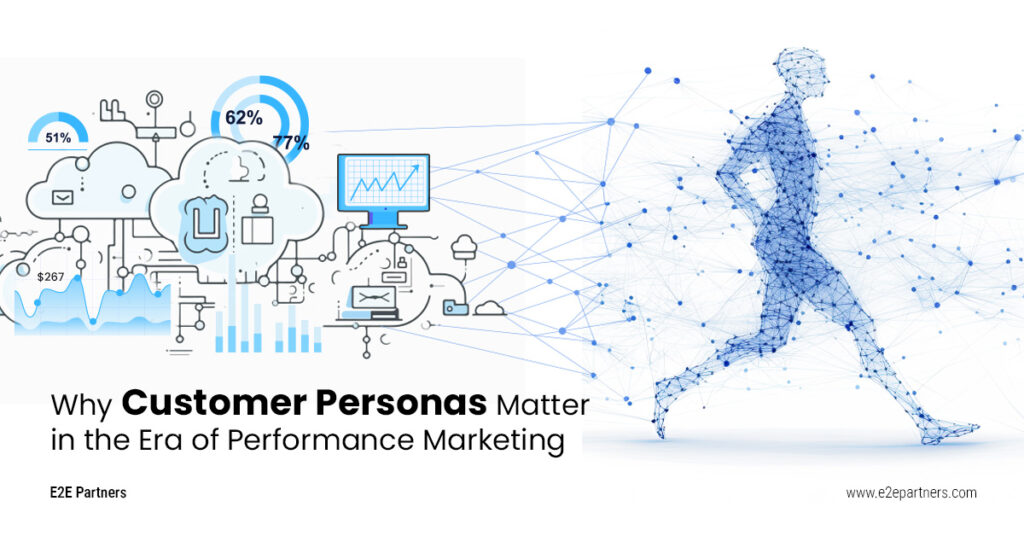
How Customer Personas Bring Humanity Back to Performance Marketing
In today’s hyper-optimised world of performance marketing – where every click, view and conversion is tracked – the human behind the screen can often become an afterthought. As digital marketing continues to evolve, the pursuit of performance has become increasingly data-driven. Campaigns are optimised in real-time, success is measured in metrics and automation powers most of the funnel. However, in the race for conversions and efficiency, the human essence of marketing – the customer – can often be reduced to little more than a data point.
Performance marketing is often perceived as a pure numbers game: reach, clicks, conversions. But without a clear understanding of who you are targeting and why they should care, results plateau quickly. Far from being outdated relics of traditional marketing, personas provide the emotional and contextual depth that performance campaigns need to stand out, resonate and ultimately convert. They are not opposed to data – they enrich it.
Personas help marketers craft messages that are not only algorithmically relevant but also emotionally authentic, helping to drive both short-term results and long-term brand equity. By aligning digital marketing with real human needs, motivations and behaviours, businesses can build richer connections, reduce friction and dramatically improve lead quality.
Why Performance Marketing Needs a Persona-Driven Strategy
What Is Performance Marketing Really About?
Performance marketing refers to a data-driven approach where marketing strategies are evaluated based on measurable results, such as conversions and leads. By definition, it seeks tangible outcomes – clicks, leads, conversions, revenue. While these indicators are vital for tracking impact, they are insufficient as a strategic starting point; understanding how personas matter is crucial for effective marketing. The most effective campaigns begin not with media placement or budget allocation, but with a deep understanding of the intended audience. This context underscores the importance of accurately defining and understanding buyer personas, which serve as the foundation for successful campaigns. By leveraging analytics and customer feedback, marketers can refine their strategies to align with the demographics and specific needs of their target audience. In essence, performance marketing thrives on a clear understanding of customer personas, allowing businesses to optimise their marketing campaigns for maximum impact and efficiency.
Moreover, the definition of performance marketing extends beyond mere metrics. It involves a comprehensive approach that integrates various marketing channels and techniques to create a cohesive customer journey. Effective performance marketing hinges on the strategic groundwork laid before media spend begins. Personas form part of this foundation – defining who you want to reach, why they buy, and how to engage them in ways that feel relevant, timely and persuasive. Without this clarity, even the most technically sound campaign risks becoming a shot in the dark.
Targeting vs. Understanding: Why Buyer Personas Matter More Than Ever
Marketers often conflate targeting with understanding. Demographic targeting may help identify segments, but without deeper insight into customer motivations, pain points, and behaviours, messaging lacks resonance.
Targeting identifies where to reach individuals; personas clarify how and why to engage them. This distinction is critical. Without a nuanced appreciation of the customer’s world – what they value, what they fear, what motivates their decisions – marketing communications risk becoming impersonal, ineffective, and easily ignored.
Understanding goes beyond clicks and impressions; it’s about empathy. Developing personas allows businesses to move from surface-level segmentation to informed communication. It ensures that what’s said matters to the person hearing it – because it reflects something they recognise in themselves.
Furthermore, the gap between targeting and understanding can lead to missed opportunities in performance marketing. Brands that rely solely on demographic data without delving into the emotional and psychological factors driving customer decisions risk alienating potential buyers. By prioritising persona development, marketers can craft messages that align with the audience’s needs and desires, fostering stronger connections and ultimately driving better performance in campaigns. This strategic approach ensures that marketing efforts are not only targeted but also informed by the real-world experiences of customers.
Using Customer Personas to Drive Lead Generation and Conversion
How to Create Customer Personas That Actually Work
The development of authentic personas that genuinely mirror real customers constitutes an essential component of a successful marketing strategy. Through the utilization of both qualitative and quantitative research methodologies, marketers are able to obtain valuable insights that guide the formation of these personas. This procedure entails conducting surveys among current customers and analyzing data to discern prevalent characteristics, behaviors, and challenges. By comprehending these factors, marketers can craft customer personas that not only reflect demographic information but also encapsulate the distinctive attributes and aspirations of the intended audience.
Additionally, the impact of well-crafted personas extends beyond initial marketing campaigns. They serve as a reference point for all marketing efforts, guiding content marketing strategies and influencing product or service development. When marketers utilise personas to tailor their messages, they create a more personalised customer experience that resonates with the audience. Ultimately, this deeper understanding of customers leads to improved engagement and higher conversion rates as marketing messages become more relevant and meaningful.
Using Ideal Customer Profiles to Align Sales, Marketing and Lead Generation
Developing Ideal Customer Profiles (ICPs) is essential for aligning sales and marketing efforts effectively. An ICP is a detailed description of the type of customer that would benefit most from a company’s product or service. By creating ICPs based on data-driven insights, marketers can ensure that their outreach is focused on the right audience. This alignment not only enhances lead generation efforts but also increases the likelihood of conversion by targeting customers who are already inclined to engage with the brand.
Moreover, the development of ICPs informs marketing strategies on multiple levels. It allows sales teams to prioritise leads that fit the ideal profile while enabling marketers to create tailored content that addresses specific customer needs. By refining their approach based on ICPs, businesses can cultivate stronger relationships with prospects and enhance the overall customer journey. This strategic focus ensures that marketing campaigns are not only efficient but also effective in driving meaningful engagement and ultimately achieving business objectives.
Mapping Pain Points to Build Better Personas and Smarter Strategies
Pain point mapping is a strategic process that involves identifying and understanding the challenges faced by target customers. By recognising these pain points, marketers can tailor their messaging and solutions to address specific needs. This approach not only enhances customer experience but also positions the brand as a trusted partner in solving real issues. By leveraging insights gained from pain point mapping, businesses can create marketing campaigns that resonate with their audience, ultimately leading to increased engagement and higher conversion rates.
Furthermore, pain point mapping serves as a guiding principle in the persona development process, ensuring that the created personas reflect real customer challenges. It enables marketers to create customer personas that are not only demographic representations but also semi-fictional reflections of the emotional and practical challenges customers face. By aligning marketing efforts around these pain points, companies can ensure that their messaging is relevant and impactful. This strategic alignment fosters stronger connections with customers, ultimately driving loyalty and enhancing the overall effectiveness of marketing campaigns.
Applying AIDA to Persona-Based Performance Messaging
Why AIDA Still Works in a Data-Driven Digital Marketing Landscape
The AIDA model—Attention, Interest, Desire, and Action—remains a powerful framework for shaping messaging strategies in performance marketing. By applying this model, marketers can create content that captures attention and generates interest in their products or services. Each stage of the AIDA framework is designed to guide potential customers through the sales funnel, ensuring that messaging is tailored to resonate with their evolving needs and motivations. This structured approach enables businesses to create more effective marketing campaigns that drive engagement and conversion rates.
Additionally, the AIDA model supports the idea of personalization in marketing. By understanding the specific needs of different personas, marketers can craft messages that speak directly to their audience’s desires and pain points. This personalized approach not only enhances the customer experience but also increases the likelihood of action. As potential customers progress through the sales funnel, the AIDA framework ensures that messaging remains aligned with their journey, ultimately leading to higher conversion rates and more impactful marketing efforts.
Tailoring Your Messaging Funnel with Buyer Personas at Every Stage
Tailoring messaging to align with different stages of the sales funnel is crucial for maximizing the effectiveness of marketing campaigns. At the awareness stage, the focus should be on capturing attention and generating interest through compelling content that addresses the audience’s pain points. As customers move to the consideration stage, marketers can provide more in-depth information that highlights the benefits of their product or service. Finally, at the decision stage, messaging should emphasize urgency and provide clear calls to action that encourage prospects to take the final step toward conversion.
Moreover, by aligning messaging with the sales funnel stages, marketers can create a cohesive narrative that guides potential customers seamlessly from one stage to the next. This approach not only enhances the customer journey but also builds trust and credibility with the audience. By utilizing insights from persona development, marketers can ensure that their messaging resonates with specific needs and preferences at each stage of the funnel. As a result, businesses can achieve higher conversion rates and ultimately drive more successful marketing efforts.
Executing Meta Ads and Digital Marketing Campaigns with Personas
Aligning Ad Creatives with AIDA and Customer Personas for Stronger Performance
Aligning creative assets to the AIDA model and customer personas is essential for effective execution in performance marketing. By ensuring that all marketing materials, whether they are digital ads, social media posts, or email campaigns, resonate with the intended audience, marketers can create a cohesive experience that drives engagement. Each creative asset should be designed to capture attention, generate interest, cultivate desire, and prompt action, all while reflecting the unique characteristics of the personas being targeted.
Furthermore, this alignment enhances the overall effectiveness of marketing campaigns. When creative assets are tailored to the specific needs and preferences of customer personas, the likelihood of conversion increases significantly. Marketers can leverage insights gained from previous campaigns and customer feedback to refine their creative strategies continuously. This iterative process not only improves the quality of creative assets but also ensures that they remain relevant and impactful, ultimately leading to enhanced performance in digital marketing efforts.
Smarter Targeting and Budgeting Through Persona-Driven Performance Marketing
Smart targeting and budgeting are critical components of successful performance marketing. By using data-driven insights to inform targeting strategies, marketers can ensure that their efforts are focused on the right audience segments. This precision not only optimizes marketing budgets but also enhances the overall effectiveness of campaigns. By identifying high-potential customer personas and allocating resources accordingly, businesses can maximize their return on investment and drive better results.
Moreover, effective budgeting involves not only resource allocation but also continuous monitoring of campaign performance. By analyzing key performance indicators (KPIs) and adjusting strategies based on real-time analytics, marketers can refine their approaches to ensure that they remain aligned with customer needs. This adaptive strategy allows businesses to respond quickly to changing market dynamics and customer preferences, ultimately leading to more successful marketing campaigns that deliver tangible results. In this way, smarter targeting and budgeting become integral to achieving long-term success in performance marketing.
Emotional Marketing: The Secret Layer Behind High-Converting Campaigns
Why Emotions Drive Conversions: The Hidden Power of Buyer Personas
Emotional marketing has emerged as a crucial layer in performance marketing, as it taps into the psychological triggers that drive consumer behavior. By appealing to emotions, brands can create connections that resonate with their audience on a deeper level. This connection not only influences decision-making but also fosters brand loyalty and trust. Marketers who understand the emotional drivers behind their customer personas can craft messages that evoke feelings, ultimately leading to higher engagement and improved conversion rates.
Moreover, the integration of emotional marketing into performance strategies enhances the overall effectiveness of campaigns. By aligning messaging with the emotional needs and desires of different personas, businesses can create more impactful customer experiences. This emotional resonance encourages customers to take action, whether that means making a purchase, sharing content, or advocating for the brand. In a competitive marketplace, the ability to connect emotionally with customers can differentiate a brand and drive long-term success.
Emotional Triggers That Convert: Creating Better Personas for Lead Generation
Understanding the emotional angles that resonate with different personas is essential for crafting effective marketing strategies. Each persona is shaped by unique experiences, aspirations, and pain points, which influence their emotional responses. By identifying these emotional triggers, marketers can tailor their messaging to evoke the desired response from their target audience. This targeted approach not only enhances customer engagement but also strengthens brand affinity, as customers feel understood and valued.
Furthermore, employing emotional angles in marketing campaigns allows businesses to stand out in a crowded marketplace. When messages are crafted to reflect the emotional needs of customer personas, they become more relatable and compelling. This relatability fosters meaningful connections, encouraging customers to engage with the brand on a deeper level. As a result, emotional marketing not only drives immediate action but also contributes to long-term customer loyalty and advocacy, solidifying the brand’s position in the market.
Strategic Takeaways: What High-Performing Persona-Driven Campaigns Have in Common
In summary, the importance of customer personas in performance marketing cannot be overstated. By understanding and embracing the nuances of buyer personas, businesses can refine their marketing strategies to align with customer needs. This alignment enhances the effectiveness of marketing efforts, leading to improved engagement and conversion rates. Additionally, the integration of emotional marketing and the AIDA model further strengthens the connection between brands and their audiences, creating impactful customer experiences that drive loyalty.
Moreover, the lessons learned from persona development and strategic targeting underscore the need for continuous refinement and adaptation in marketing efforts. By leveraging data, analytics, and customer feedback, marketers can ensure that their personalized marketing strategies remain relevant in an ever-changing landscape. Ultimately, the key takeaway is that, in performance marketing, a deep understanding of customer personas is essential for driving success and achieving long-term business goals.
Conclusion: Why People-Focused Marketing Wins in the Long Run
In the realm of performance marketing, the emphasis on people and their unique needs is what ultimately drives success. By leveraging customer personas, marketers can create targeted strategies that resonate with their audience on a personal level. This focus on understanding the individual customer experience not only enhances engagement but also fosters lasting loyalty. As businesses continue to navigate the digital landscape, the ability to humanize marketing efforts will remain a critical factor in achieving sustainable growth and success.
As we move forward, it is evident that while performance metrics are essential, the human element cannot be overlooked. The integration of emotional marketing, personalized strategies, and a strong understanding of customer personas will be key in establishing impactful connections that drive results. In a world where technology continues to evolve, the timeless truth remains: in performance marketing, people still win.

Patricia Munginga
E2E Partners

